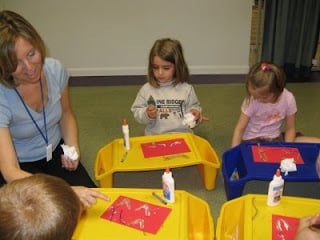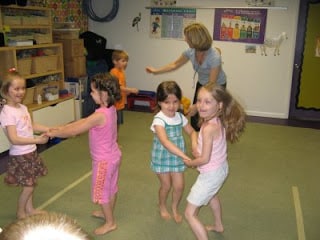Home Activities Suggestions: 1) Read the story from your book together. 2) Ask your child to tell you the story in his/her own words. Write down what the child says (word for word, if possible). Then have your child draw picture of the crocodile to complete the story. 3) Dance to the “Gamelan” song on your Home CD. Explore movements and build your child’s vocabulary by labeling the different ways to move. Here are a few examples: · Move arms slowly and smoothly · Move arms slowly but with sharp movements · Move around the room in a “curvy” path · Move ins a straight path with arms moving in strong, quick, sharp ways · Move quickly in a curvy path with arms up high moving smoothly · Leap in a straight path, then stop and twist your hips. Alternate between leaping and twisting, as described. · Hop n a zig-zag path on one foot, then curl slowly in a small ball. Uncurl and hop on one foot in a zig-zag path again. 4) Play along to “Mrs. Murphy’s Chowder” using your lummi sticks. (review from day 1) Lesson Focus: Melodic Contour – Today your child explored the contour of the melody in the “Yangtze Boat Song”. First we used our hands, then added scarves. Finally, we applied what we were hearing with the movement of our body to create a “melodic contour” picture using craft supplies. We also discovered that the melody follows the Form of AABA. Try listening to this song at home and finding the AABA pattern in the melody. Gamelan is a traditional Indonesian instrumental ensemble comprised mainly of percussions instruments. Based on tradition, gamelan music is created by communities. All members of a gamelan ensemble are equally important. There is no distinction between professional and amateur players, classical and new music, or ritual and entertainment performances. Today we listened to a “Gamelan” piece of music and identified some of the instruments being played. Rhythm At An Early Age – Rhythm is one of the fundamental building blocks of music. When your child participates in rhythm activities, such as moving to the beat of music, clapping and stamping along with poetry and songs, or playing rhythms on instruments, she is integrating, in a fun and natural way, the tools she will use for language, coordination, movement, and of course, music! Being able to feel and experience the rhythm of words and music (as opposed to simply understanding the concept of rhythm as a child exposed to music at a later age might be trained to do) is an enormous part of a fulfilling musical life.






Leave a Reply